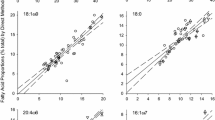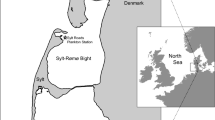Abstract
The unambiguous identification of discrete sources of organic matter is critical for understanding the processes that affect ecosystem structure. Here, we demonstrate how changes in the relative proportions of highly branched isoprenoid lipids can provide a straightforward analytical method to distinguish between organic matter derived from sea ice and seawater within an Arctic ecosystem. In combination with stable isotope analysis, we reconstruct the organic matter pathway across trophic levels, thereby elucidating specific organic matter energy transfers. Combined, these methods will provide a useful analytical approach for determining ecosystem structure in the future. This is likely to become increasingly important as the Arctic continues to experience a phase of rapid climate change.



Similar content being viewed by others
References
Belt ST, Massé G, Rowland SJ, Poulin M, Michel C, LeBlanc B (2007) A novel chemical fossil of palaeo sea ice: IP25. Org Geochem 38:16–27
Belt ST, Brown TA, Navarro-Rodriguez A, Cabedo-Sanz P, Tonkin A, Ingle R (2012) A reproducible method for the extraction, identification and quantification of the Arctic sea ice proxy IP25 from marine sediments. Anal Methods 4:705–713
Belt ST, Brown TA, Ringrose AE, Cabedo-Sanz P, Mundy CJ, Gosselin M, Poulin M (2013) Quantitative measurement of the sea ice diatom biomarker IP25 and sterols in Arctic sea ice and underlying sediments: further considerations for palaeo sea ice reconstruction. Org Geochem 62:33–45
Brown TA (2011) Production and preservation of the Arctic sea ice diatom biomarker IP25. PhD thesis. University of Plymouth, Plymouth
Brown TA, Belt ST (2012a) Closely linked sea ice–pelagic coupling in the Amundsen Gulf revealed by the sea ice diatom biomarker IP25. J Plankton Res 34:647–654
Brown TA, Belt ST (2012b) Identification of the sea ice diatom biomarker IP25 in Arctic benthic macrofauna: direct evidence for a sea ice diatom diet in Arctic heterotrophs. Polar Biol 35:131–137
Brown TA, Belt ST, Philippe B, Mundy CJ, Massé G, Poulin M, Gosselin M (2011) Temporal and vertical variations of lipid biomarkers during a bottom ice diatom bloom in the Canadian Beaufort Sea: further evidence for the use of the IP25 biomarker as a proxy for spring Arctic sea ice. Polar Biol 34:1857–1868
Brown TA, Belt ST, Piepenburg D (2012) Evidence for a pan-Arctic sea-ice diatom diet in Strongylocentrotus spp. Polar Biol 35:1281–1287
Brown TA, Belt ST, Ferguson SH, Yurkowski DJ, Davison NJ, Barnett JEF, Jepson PD (2013a) Identification of the sea ice diatom biomarker IP25 and related lipids in marine mammals: A potential method for investigating regional variations in dietary sources within higher trophic level marine systems. J Exp Mar Biol Ecol 441:99–104
Brown TA, Bicknell AWJ, Votier SC, Belt ST (2013b) Novel molecular fingerprinting of marine avian diet provides a tool for gaining insights into feeding ecology. Environ Chem Lett 11:283–288
Dehn L-A, Sheffield GG, Follmann EH, Duffy LK, Thomas DL, O’Hara TM (2007) Feeding ecology of phocid seals and some walrus in the Alaskan and Canadian Arctic as determined by stomach contents and stable isotope analysis. Polar Biol 30:167–181
DeNiro MJ, Eptein S (1978) Influence of diet on the distribution of carbon isotopes in animals. Geochim Cosmochim Acta 42:495–506
Forest A, Tremblay J-É, Gratton Y, Martin J, Gagnon J, Darnis G, Sampei M, Fortier L, Ardyna M, Gosselin M, Hattori H, Nguyen D, Maranger R, Vaqué D, Marrasé C, Pedrós-Alió C, Sallon A, Michel C, Kellogg C, Deming J, Shadwick E, Thomas H, Link H, Archambault P, Piepenburg D (2011) Biogenic carbon flows through the planktonic food web of the Amundsen Gulf (Arctic Ocean): a synthesis of field measurements and inverse modelling analyses. Prog Oceanogr 91:410–436
Goutte A, Cherel Y, Houssais M-N, Klein V, Ozouf-Costaz C, Raccurt M, Robineau C, Massé G (2013) Diatom-specific highly branched isoprenoids as biomarkers in Antarctic consumers. PLoS ONE 8:e56504
Graeve M, Kattner G, Hagen W (1994) Diet-induced changes in the fatty acid composition of Arctic herbivorous copepods: experimental evidence of trophic markers. J Exp Mar Biol Ecol 182:97–110
Harwood LA, Smith TG, Melling H, Alikamik J, Kingsley MCS (2012) Ringed seals and sea ice in Canada’s Western Arctic: harvest-based monitoring 1992–2011, vol 65. 2012, vol 4
Hobson KA, Schell DM, Renouf D, Noseworthy E (1996) Stable carbon and nitrogen isotopic fractionation between diet and tissues of captive seals: implications for dietary reconstructions involving marine mammals. Can J Fish Aquat Sci 53:528–533
Iverson SJ, Field C, Bowen WD, Blanchard W (2004) Quantitative fatty acid signature analysis: a new method of estimating predator diets. Ecol Monogr 74:211–235
Juul-Pedersen T, Michel C, Gosselin M, Seuthe L (2008) Seasonal changes in the sinking export of particulate material under first-year sea ice on the Mackenzie Shelf (western Canadian Arctic). Mar Ecol-Prog Ser 353:13–25
Loseto LL, Stern GA, Deibel D, Connelly TL, Prokopowicz A, Lean DRS, Fortier L, Ferguson SH (2008) Linking mercury exposure to habitat and feeding behaviour in Beaufort Sea beluga whales. J Mar Syst 74:1012–1024
MacArthur R (1955) Fluctuations of animal populations and a measure of community stability. Ecology 36:533–536
Magen C, Chaillou G, Crowe SA, Mucci A, Sundby B, Gao A, Makabe R, Sasaki H (2010) Origin and fate of particulate organic matter in the southern Beaufort Sea—Amundsen Gulf region, Canadian Arctic. Estuar, Coast Shelf Sci 86(1):31–41
Morata N, Poulin M, Renaud PE (2011) A multiple biomarker approach to tracking the fate of an ice algal bloom to the sea floor. Polar Biol 34:101–112
Parnell AC, Inger R, Bearhop S, Jackson AL (2010) Stable-isotope comparisons between embryos and mothers of a placentatrophic shark species. PLoS ONE 5:e9672
Post DM (2002) Using stable isotopes to estimate trophic position: models, methods, and assumptions. Ecology 83:703–718
Wassmann P, Duarte CM, AgustÍ S, Sejr MK (2011) Footprints of climate change in the Arctic marine ecosystem. Glob Change Biol 17:1235–1249
Acknowledgments
TB and SB would like to thank Plymouth University for financial support. We also thank the Holman Hunters and Trappers Association for collecting seals, and in particular, Lois Harwood and John Alikamik. Collections were conducted under a Fisheries and Oceans Canada license to fish for scientific purposes (S-11/12-1010-NU-A1), supported by Natural Sciences and Engineering Research Council of Canada—Ocean Tracking Network (DJY).
Author information
Authors and Affiliations
Corresponding author
Rights and permissions
About this article
Cite this article
Brown, T.A., Yurkowski, D.J., Ferguson, S.H. et al. H-Print: a new chemical fingerprinting approach for distinguishing primary production sources in Arctic ecosystems. Environ Chem Lett 12, 387–392 (2014). https://doi.org/10.1007/s10311-014-0459-1
Received:
Accepted:
Published:
Issue Date:
DOI: https://doi.org/10.1007/s10311-014-0459-1




